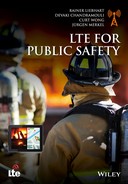Foreword
Foreword by Dr. Hossein Moiin
People love Long-Term Evolution (LTE). At 280 million LTE subscribers globally in October 2014, LTE has been adopted faster than any previous generation of mobile technology. The time to reach one billion subscribers is expected to be 7 years, as compared to 11 years for 3rd Generation (3G) and 12 years for Global System for Mobile Communications (GSM). LTE also has the biggest and fastest growing device ecosystem. With 331 commercially launched LTE networks in 112 countries today and more than 600 operator commitments, it has become the technology of choice for operators. I believe that LTE will outgrow other technologies to become the unrivaled fabric of mobile broadband, thanks to its feature richness, wide spectrum availability, and economy of scale.
As a technology, LTE has many unique characteristics that make it suitable for extension to services beyond basic mobile broadband. LTE is not only built upon improved radio principles with peak data rates beyond 150 Mbps, scalable bandwidth, and low latency but also has a much simplified Internet Protocol (IP)/Internet-based two-node architecture. As a result, LTE broadens the reach of mobile communications in the future by providing a platform for services such as LTE for Public Safety, LTE for TV Broadcast, LTE in Unlicensed and in UHF bands, LTE for M2M, LTE for Device-to-Device communication, and many other applications such as LTE for Connected Cars and for Airplanes.
Public Safety networks in particular benefit tremendously by using LTE as the base technology, which not only fulfills the specific communication needs of emergency services such as robustness and low latency but is also supported widely in commercial cellular systems already in use by people all over the world. Equally important is the fact that LTE for Public Safety standardization work benefits from the excellence in global standardization processes achieved by 3rd Generation Partnership Program (3GPP), as demonstrated in the superior craftsmanship of LTE that met user expectation with the first release and had the fastest and most stable standards.
Nokia Networks is actively driving the LTE for Public Safety standardization work in 3GPP and is the lead rapporteur in 3GPP SA/CT WGs for group communication, an essential feature for Public Safety. Dedicated efforts led by the authors of this book, Rainer Liebhart, Devaki Chandramouli, Curt Wong, and Jürgen Merkel, have been instrumental in elevating LTE for Public Safety, from a niche topic facing much resistance into the most supported system-level work in 3GPP Release 12.
I believe that LTE is the right technology for evolving Public Safety networks over mobile broadband, offering totally new and much more efficient ways for Public Safety personnel to communicate in the future. I do like to thank the authors for bringing out this book that will definitely help readers gain a detailed understanding of the technology behind LTE for Public Safety and the related aspects such as spectrum, architecture, features, interworking, and deployment scenarios.
Hossein Moiin
EVP, Technology & Innovation Leader
Nokia, Networks Division
Foreword by Mr. Andrew Thiessen
Public Safety's selection of the 3GPP LTE signals the beginning of a foundational movement by Public Safety away from the niche technology of the past – Land Mobile Radio (LMR) – to an advanced technology being embraced by the commercial marketplace. This move will allow Public Safety to reap the benefits of a market many times the size of the LMR market. Not the least of these benefits is access to a never-ending stream of technology refresh, something that has never been available to narrow-band voice systems.
The 3GPP community has shown significant support of Public Safety's decision to move to LTE. This is evident in the progress being made in closing the gaps between Public Safety's current mission critical voice requirements and the features provided by LTE. Specifically, the creation of Proximity Services (ProSe) within 3GPP will allow Public Safety user devices to communicate without infrastructure, which the Public Safety community in the United States considers fundamental to a mission-critical-capable technology. Similarly, the addition of Group Communications Systems Enablers for LTE (GCSE_LTE) will provide for efficient group communications, which is the predominant method by which the first responder community communicates. 3GPP made an additional commitment to the Public Safety community with the creation of a new working group chartered to work on applications and services, first among which will be mission critical push to talk (MCPTT).
So, for the first time, the global Public Safety community is coming together in a single standards development organization, around a single technology, to work collaboratively with commercial mobile network operators and equipment providers to move the world toward a communications environment that will more effectively support first responders as they carry out their vital mission to protect lives and property.
This book provides a detailed synopsis of recent achievements made in 3GPP to advance this important work; in particular, it describes the Public Safety specific features ProSe and GCSE_LTE. The authors are deeply involved in the work on LTE for Public Safety and are in a position to provide valuable firsthand insights on 3GPP and the relevant technical details.
Andrew Thiessen
Deputy Program Manager
U.S. Department of Commerce
Public Safety Communications Research Program
